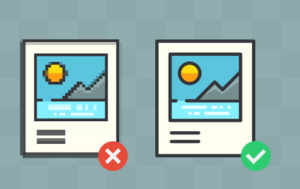SEO Images: Guide to Optimize Images for Web
We all know that when you are a blogger or a write for an online newspaper or magazine, using images improves the appeal of your article. However, the images play a role for your SEO as well. As a result, it is important to carefully consider which SEO images you want to use and how.
With our image for SEO guide, we aim to help you understand the importance of using and to optimize images for web and how you can effectively use them to improve your user experience.

Why Use Image for SEO?
As we have mentioned SEO image optimization can help your site rank better and improve the user experience. Therefore, it is important to think about the SEO images you are going to use together with the topic for your article.
As for improving user experience, no one will be interested in your article if there are no images that further extends your topic visually. e.g. If an article looks like a word document, it will not be memorable, and the reader may not feel like they can trust the site and story.
Finding the Right SEO Images
- The right image size – The right sized image for SEO will affect the loading time of the page positively. That is because no one wants to wait very long for your article to load. The reader will lose interest in the article and move to another one which will load quickly. This, in turn, can affect your bounce rate.
- Right image format – There are different image formats which include PNG, JPEG, GIF, ICO, PDF, PSD. The most accepted formats for all kinds of platforms are PNG, JPEG, and GIF. As a result, if you know which types of platforms your readers are using, you can easily use formats that are compatible.
- Resizing the image – It is important to resize images before uploading them unless the image is already in the correct site. This will help the Google image SEO to be the perfect size in proportion to your content on your article.
- Compressing the image – SEO images should also be compressed because it reduces the file size. If you upload a big image that is not proportioned to your content, it will affect the loading time of your page. Therefore, it is recommended to use images that are between 1500 and 2500 pixels wide and optimize images for websites.
- Correctly naming the image – Correctly naming images for SEO will help Google know what the picture is about before it even looks at it. This is important to help Google index your image and also to know that the image is related to the content or further describes the content.

Uploading and Optimizing Images for Website
The image sizes differ depending on the theme of the Content Management System (CMS) sites such as WordPress. The image SEO WordPress resizes the images to display correctly in their different formats. It is best to upload an image that is big enough to be reduced without losing the quality and resolution, to use the site optimally. WordPress will save images as a thumbnail, a medium copy and a full-size copy, all in different file sizes.
It is important to note that when uploading your images, they should be named accordingly. Once you have uploaded the image, to further improve your SEO for images, add alt text and a title to your images. This will further help google and other SERPs to know what the image is all about. It is also important to use your keywords on the alt text and title.
Favicon SEO Image Optimization
Favicons can be used in replacement of SEO images HD. They are beneficial because they are much smaller in size compared to SEO images. If you want to add favicons on your pages, it is advised that they are saved as PNG or ICO formats.
The recommended file dimensions for a favicon are 100px × 100px to 300px × 300px. However, they will appear on the browser as 16px × 16px. Internet Browser does not display Favicons that are saved as PNGs.
![]()
Image SEO Tips
Below are SEO tips for images to always keep in mind when looking for images that will improve your SEO:
- Use relevant, high-quality SEO images
- Customize the filename – SEO image descriptions give context to the image. Use the keywords for images and SEO
- Use the best image alt tags SEO best practices – use SEO keywords you are targeting on alt tags
- Choose the right file type – whether it be PNG, JPEG or GIFs
- Add SEO images to your sitemap – this is for SEO images Google. It will give Google an idea of what your site is about
- Don’t scale images too small and try to re-enlarge them; they will appear pixelated and blurry
- SEO image optimizer – Adjusting your image size in the <img> tag will not change the size that was saved, it only affects the display size
- Choose the smallest size that is the same or larger than the display size, and use the <img> tags to adjust the size will be displayed on your content
- Image SEO best practices – Before uploading the image, make edits, that includes before compressing the image


